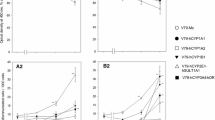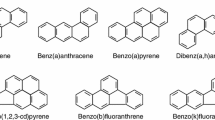Summary
The effects of dietary polychlorinated biphenyls (PCBs) on hepatocarcinogenesis in female rats of Donryu strain receiving 3′-methyl-4-dimethyl-aminoazobenzene (3′-Me-DAB) were investigated. Oral administration of PCBs after administration of 3′-Me-DAB resulted in a high incidence (64%) of hepatocarcinoma. In contrast, administration of a similar amount of PCBs before, or together with 3′-Me-DAB did not induce hepatic tumors. Administration of a slightly larger amount of PCBs alone did not induce liver tumors, while administration of a slightly larger amount of 3′-Me-DAB alone caused only a low incidence (13%) of hepatocarcinoma. These results strongly suggest that PCBs exert a potent promoting action in experimental azo dye hepatocarcinogenesis.
Similar content being viewed by others
References
Baba,T.: Inhibitory effect of p-hydroxypropiophenone upon experimental induction of hepatoma in rats fed with butter-yellow (DAB). Gann 48, 145–158 (1957)
Castagna,M., Hamon,G., Chauveau,J.: Studies on the inhibition by ethionine of aminoazo dye carcinogenesis in rat liver. Cancer Res. 32, 1960–1965 (1972)
Chen,T.S., Dubois,K.P.: Studies on the enzyme inducing effect of polychlorinated biphenyls. Toxicol. Appl. Pharmacol. 26, 504–512 (1973)
Clayton,C.C., Baumann,C.A.: Diet and azo dye tumors: Effect of diet during a period when the dye is not fed. Cancer Res. 9, 575–582 (1949)
Edwards,J. E.: Pathologic changes with special reference to pigmentation and classification of hepatic tumors in rats fed p-dimethylaminoazobenzene (butter-yellow). J. Nat. Cancer Inst. 2, 157–183 (1941)
Fujita,S., Tsuji,H., Kato,K., Saeki,S., Tsukamoto,H.: Effect of biphenyl chlorides on rat liver microsomes. Fukuoka Acta med. 62, 30–34 (1971)
Gram T.E., Rogers,L.A., Fouts,J.R.: Effect of pretreatment of rabbits with phenobarbital or 3-methylcholanthrene on the distribution of drug-metabolizing enzyme activity in subfractions of hepatic microsomes. J. Pharmacol. Exp. Ther. 157, 435–445 (1967)
Ito,N., Farber,E.: Effects of trypan blue on hepatocarcinogenesis in rats given ethionine or N-2-fluorenylacetamide. J. Nat. Cancer Inst. 37, 775–785 (1966)
Ito,N., Hiasa,Y., Konishi,Y., Maugami,M.: The development of carcinoma in liver of rats treated with m-toluenediamine and the synergistic and antagonistic effects with other chemicals. Cancer Res. 29, 1137–1145 (1969)
Ito,N., Nagasaki,H.; Arai,M., Makiura,S., Sugihara,S., Hirao,K.: Histopathologic studies on liver tumorigenesis induced in mice by technical polychlorinated biphenyls and its promoting effect on liver tumors induced by benzene hexachloride. J. Nat. Cancer Inst. 51, 1637–1646 (1973)
Jellinck,P.H., Smith,G., Fletcher,R.: Nature of the water-soluble metabolites of 7, 12-dimethylbenz(a)anthracene formed by liver microsomes of normal and 3-methylcholanthrene-treated rats. Cancer Res. 30, 1715–1721 (1970)
Kanematsu,T.: Promoting effect of carbon tetrachloride on azo-dye hepatocarcinogenesis in rats. Fukuoka Acta med. 67, 134–145 (1976)
Kato,R., Shoji,H., Takanaka,A.: Metabolism of carcinogenic compounds. I. Effect of phenobarbital and methylcholanthrene on the activities of N-demethylation of carcinogenic compounds by liver microsomes of male and female rats. Gann 58, 467–469 (1967)
Kimura,N.T., Baba,T.: Neoplastic changes in the rat liver induced by polychlorinated biphenyl. Gann. 64, 105–108 (1973)
Lotlikar,P.D.: Effects of 3-methylcholanthrene pretreatment on microsomal hydroxylation of 2-acetaminofluorene by various rat hepatomas. Biochem. J. 118, 513–518 (1970)
Makiura,S., Aoe,H., Sugihara,S., Hirao,K., Arai,M., Ito,N.: Inhibitory effect of polychlorinated biphenyls on liver tumorigenesis in rats treated with 3′-methyl-4-dimethylaminoazobenzene, N-2-fluorenylacetamide, and diethylnitrosamine. J. nat. Cancer Inst. 53, 1253–1257 (1974)
Miller,J.A., Baumann,C.A.: The carcinogenicity of certain azo dyes related to p-dimethylaminoazobenzene. Cancer Res. 5, 227–234 (1945)
Miller,J.A., Miller,E.C.: The carcinogenicity of certain derivatives of p-dimethylaminoazobenzene in the rat. J. exp. Med. 87, 139–156 (1948)
Oota,K., Matsumoto,S.: Collision of multicentric cancerous foci against each other in experimental rat liver cancer. Gann 45, 581–590 (1954)
Opie,E.: The pathogenesis of tumors of the liver produced by butter yellow. J. exp. Med. 80, 231–261 (1944)
Orr,J.W.: The histology of the rat's liver during the course of carcinogenesis by butter-yellow (p-dimethylaminoazobenzene). J. Path. Bact. 50, 393–408 (1940)
Peraino,C., Fry,R.J.M., Staffeldt,E.: Reduction and enhancement by phenobarbital of hepatocarcinogenesis induced in the rat by 2-acetylaminofluorene. Cancer Res. 31, 1506–1512 (1971)
Richardson,H.L., Stier,A.R., Borsos-Nachtnebel,E.: Liver tumor inhibition and adrenal histologic responses in rats to which 3′-methyl-4-dimethylaminoazobenzene and 20-methyl cholanthrene were simultaneously administered. Cancer Res. 12, 356–361 (1952)
Saeki,S., Tsutsui,A., Oguri,K., Yoshimura,H., Hamana,M.: The isolation and structure elucidation of the main components of Kanechlor-400 (Chlorobiphenyls). Fukuoka Acta med. 62, 20–24 (1971)
Sidransky,H., Ito,N., Verney,E.: Influence of α-naphthyl-isothiocyanate on liver tumorigenesis in rats ingesting ethionine and N-2-Fluorenylacetamide. J. nat. Cancer Inst. 37, 677–686 (1966)
Sidransky,H., Verney,E.: Influence of orotic acid on liver tumorigenesis in rats ingesting ethionine, N-2-fluorenyl acetamide, and 3′-methyl-dimethylaminoazobenzene. J. nat. Cancer. Inst. 44, 1201–1215 (1970)
Squire,R.A., Levitt,M.H.: Report of a workshop on classification of specific hepatocellular lesion in rats. Cancer Res. 35, 3214–3223 (1975)
Author information
Authors and Affiliations
Additional information
This work was supported in part by Grants-in-Aid for Scientific Research from the Ministry of Education and from the Ministry of Health and Welfare, Japan
The authors thank Prof. K. Tanaka for gift of Kanechlor-400, and for treating the excreta to prevent environmental pollution by PCBs
Rights and permissions
About this article
Cite this article
Kimura, N.T., Kanematsu, T. & Baba, T. Polychlorinated biphenyl(s) as a promotor in experimental hepatocarcinogenesis in rats. Z. Krebsforsch. 87, 257–266 (1976). https://doi.org/10.1007/BF00506498
Received:
Accepted:
Issue Date:
DOI: https://doi.org/10.1007/BF00506498




